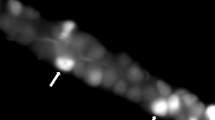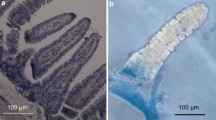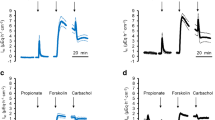Abstract
The fundus of an eel stomach was mounted in an Ussing chamber and bathed with control Ringer on the serosal side and with unbuffered solution on the mucosal side. The gastric mucosa exhibited a mucosa negative transepithelial voltage (V t), a “short circuit” current (I SC) and a small spontaneous acid secretion rate (J H). All these parameters were abolished by cimetidine treatment. Bilateral ion substitution experiments in tissues lacking spontaneous acid secretion suggested that a net Cl− transport from serosa to mucosa was responsible for the genesis of the I SC in the absence of H+ secretion. Serosal application of histamine (10−4 mol · l−1) or carbachol (10−4 mol · l−1) stimulated both I SC and J H. The action of carbachol was independent of histamine. The control as well as the histamine-stimulated I SC was sensitive to both serosal bumetanide (10−5 mol · l−1), inhibitor of the Na+-K+-2Cl− cotransport, and 4,4-diisothiocyano-stilbene-2,2-disulphonic acid (DIDS, 5 · 10−4 mol · l−1), inhibitor of the Cl−-HCO− 3 exchange, while the I SC stimulated by carbachol was nullified by serosal DIDS. These data suggested that the non-acidic Cl− uptake across the serosal membrane was linked to the activity of both Na+-K+-2Cl− cotransport and Cl−-HCO− 3 antiporter; histamine stimulated both transporters while carbachol was limited to the anion exchanger. The finding that the acid secretion was strictly dependent on serosal Cl− and was completely blocked by serosal DIDS suggested that the Cl− accompanying H+ secretion entered the cell through the serosal membrane by the Cl−-HCO− 3 exchange. In addition, the acid secretion stimulated by carbachol was also dependent on serosal Na+ and sensitive to the application of 5-N-N-dimethyl-amiloride in the serosal bath, suggesting that the increased activity of the Cl−-HCO− 3 during carbachol treatment was linked to the activation of serosal Na+-H+ exchange. The inhibitory effect of luminal omeprazole (10−4 mol · l−1) on acid secretion suggested the presence of the H+-K+ pump on the luminal membrane.
Similar content being viewed by others
Author information
Authors and Affiliations
Additional information
Accepted: 18 September 1997
Rights and permissions
About this article
Cite this article
Trischitta, F., Denaro, M., Faggio, C. et al. H+ and Cl− secretion in the stomach of the teleost fish, Anguilla anguilla : stimulation by histamine and carbachol. J Comp Physiol B 168, 1–8 (1998). https://doi.org/10.1007/s003600050114
Issue Date:
DOI: https://doi.org/10.1007/s003600050114




